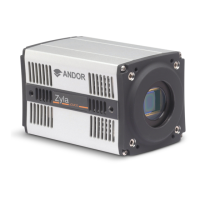version 2.0 rev 18 Feb 2021
19
2.2.2 Global Shutter (Zyla 5.5 only)
Global shutter mode, which can also be thought of as a ‘snapshot’ exposure mode, means that all pixels of
the array are exposed simultaneously. In most respects, global shutter can be thought of as behaving like an
Interline CCD sensor. Before the exposure begins, all pixels in the array will be held in a ‘keep clean state’, during
which charge is drained into the anti-bloom structure of each pixel. At the start of the exposure each pixel
simultaneously begins to collect charge and is allowed to do so for the duration of the exposure time. At the
end of exposure each pixel transfers charge simultaneously to its readout node. Importantly, global shutter can
beconguredtooperateinacontinuous‘overlap’mode(analogoustoInterlineCCD),wherebyanexposurecan
proceed while the previous exposure is being readout out from the readout nodes of each pixel. In this mode,
thesensorhasa100%dutycycle,againresultinginoptimaltimeresolutionandphotoncollectioneciency.
However, the mechanism of global shutter mode demands that a reference readout is performed ‘behind the
scenes’, in addition to the actual readout of charge from each pixel. Due to this additional reference readout,
globalshuttermodecarriesthetrade-oofhalvingthemaximumframeratethatwouldotherwisehavebeen
achieved in rolling shutter mode. In addition, global shutter also increases the RMS read noise by a factor of
1.41 over rolling shutter readout. Figure 9belowshowsasimpliedillustrationshowingsequenceofeventsin
global shutter mode:
Figure 9: Global Shutter Exposure and Readout

